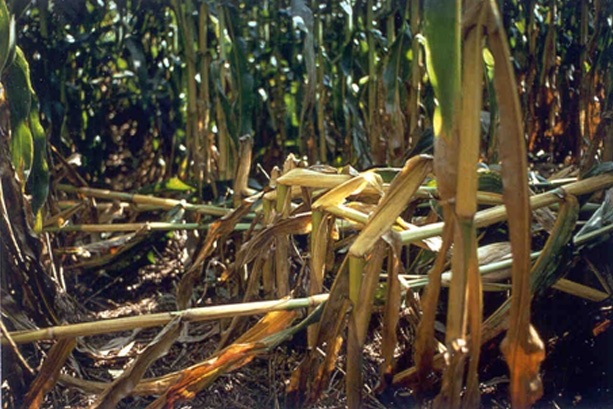September 12, 2012

Drought conditions experienced during grain fill often increase the potential for stalk rot and lodging problems in corn. When stalk rot occurs late in the season as it often does, it may have little or no direct effect on yield. However, stalk lodging, which results from stalk rot, can have such an impact on harvest losses that many plant pathologists consider stalk rots to be the most significant yield-limiting disease of corn.
For a corn plant to remain healthy and free of stalk rot, the plant must produce enough carbohydrates by photosynthesis to keep root cells and pith cells in the stalk alive and enough to meet demands for grain fill. When corn is subjected to drought stress during grain fill, photosynthetic activity is reduced. As a result, the carbohydrate levels available for the developing ear are insufficient. The corn plant responds to this situation by removing carbohydrates from the leaves, stalk, and roots to the developing ear. While this "cannibalization" process ensures a supply of carbohydrates for the developing ear, the removal of carbohydrates results in premature death of pith cells in the stalk and root tissues, which predisposes plants to root and stalk infection by fungi. As plants near maturity, this removal of nutrients from the stalk to the developing grain results in a rapid deterioration of the lower portion of corn plants in drought stressed fields with lower leaves appearing to be nitrogen stressed, brown and/or dead.
Other plant stresses which increase the likelihood of stalk rot problems include: loss of leaf tissue due to foliar diseases (such as gray leaf spot or Northern corn leaf blight), insects or hail; injury to the root system by insects or chemicals; high levels of nitrogen in relation to potassium; compacted or saturated soils restricting root growth (recent flooding); and high plant populations.
Most hybrids do not begin to show stalk rot symptoms until shortly before physiological maturity. It is difficult to distinguish between stalk rots caused by different fungi because two or more fungi may be involved. Similarly, certain insects such as European corn borer often act in concert with fungal pathogens to cause stalk rot. Although a number of different fungal pathogens cause stalk rots, the three most important in Ohio are Gibberella, Collectotrichum (anthracnose), and Fusarium. For more information on stalk rot in corn, consult the OSU Plant Pathology website Ohio Field Crop Diseases for more details and pictures of the disease symptoms associated with these pathogens.
The presence of stalk rots in corn may not always result in stalk lodging, especially if the affected crop is harvested promptly. It’s not uncommon to walk cornfields where nearly every plant is upright yet nearly every plant is also showing stalk rot symptoms. Many hybrids have excellent rind strength, which contributes to plant standability even when the internal plant tissue has rotted or started to rot. However, strong rinds will not prevent lodging if harvest is delayed and the crop is subjected to weathering, e.g. strong winds and heavy rains.
A symptom common to all stalk rots is the deterioration of the inner stalk tissues so that one or more of the inner nodes can easily be compressed when squeezing the stalk between thumb and finger. It is possible by using this "squeeze test" to assess potential lodging if harvesting is not done promptly. The "push" test is another way to predict lodging. Push the stalks at the ear level, 6-8 in. from the vertical. If the stalk breaks between the ear and the lowest node, stalk rot is usually present. To minimize losses from stalk lodging, avoid harvest delays. Identify fields that are at greatest risk and harvest them fields first. Fields that experienced drought stress, defoliation due to hail, foliar disease injury, etc. would be prime candidates for early harvest.
You May Also Like




